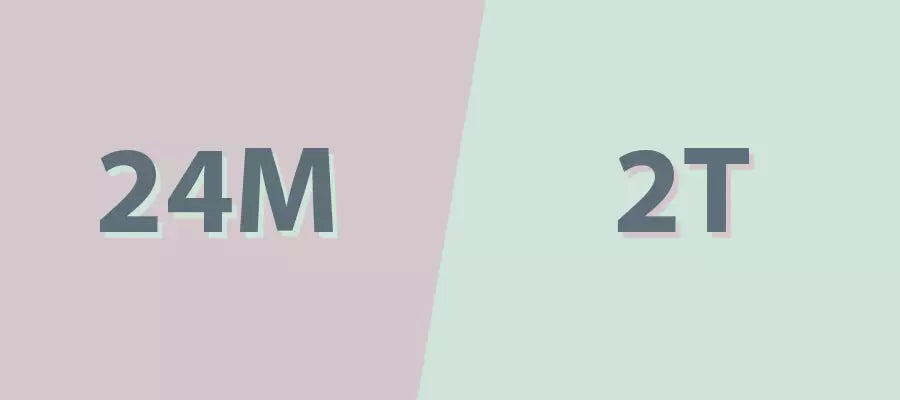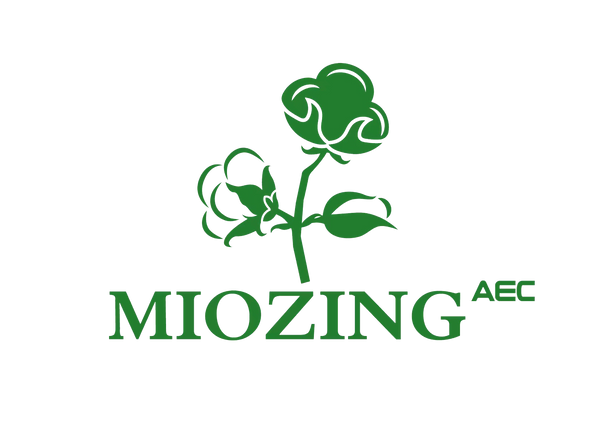
2T vs 24 Months: How much of each size should I wholesale?
Share
Ever wondered how you can get trendy baby clothes for your store without spending too much? The answer is knowing how to properly wholesale baby clothes!
Wholesale baby clothes open up endless opportunities for boutiques and shoppers. Not only do they save costs, they also offer a wide variety of products. Buying in bulk helps manage inventory and increase profits. Considering wholesale baby clothes for your boutique? It’s not just about saving money, it’s about staying in business for the long term and satisfying your customers. Let’s explore wholesale purchasing together and stand out in this niche!
In Kids Clothes, What Does 2T Stand For?
2T stands for? Short for "2 Toddler," this size is designed specifically for those active children between the ages of 2 and 3. Kids clothes world revolves on this staple, thus as wholesalers, we must know exactly what it offers.
Sizing and Fit of 2T Clothing
2T clothes' sizing and fit are meant for active toddlers. Usually, it fits children weighing between 26 and 30 pounds and who fall between 33 and 36 inches tall. The catch is, though, these are merely averages! Since every baby clothes supplier has somewhat different size charts, we always advise consulting manufacturer specifics. 2T fits smaller children who are walking, running, and exploring better than baby sizes. It’s less roomy than, say, 24-month clothing, making it ideal for toddlers transitioning out of diapers.
Typical Age Range of 2T Clothing
Generally, we’re looking at toddlers aged 2 to 3 years. Said another way, children develop at their own speed. While some rock it well past their third, others leap into 2T before their second birthday. It's about height, weight, and body shape, not only about age. Depending on the kiddos our clients are dressing for, this flexibility means 2T vs 24 months can overlap in demand for us wholesale buyers. Knowing this enables us to advise stores on what to expect and properly inventory wholesale baby clothes.
Key Features of 2T Clothing
2T clothes is all about meeting active toddler needs. Designed to fit small children who are on the move—walking, running, and investigating—it has a slimmer fit than baby sizes. Often durable and flexible, the materials are ideal for withstanding the rigors of play. Our 2T baby clothes also have careful design elements, which makes changing diapers and dressing easy. Parents depend on these qualities most of all, thus as wholesalers we must emphasize them when we are filling our inventory.

In kids clothes, what does 24 months mean?
If you’re navigating the world of wholesale kids clothes, you’ve likely come across the 24-month size. But what exactly does it mean, and how does it differ from 2T? Let’s clear up the confusion.
Fit and Sizing of 24-Month Baby Clothes
Infants between the ages of eighteen and twenty-four months should fit this size. Usually, it fits youngsters weighing 22 to 26 pounds and between 30 and 33 inches in height. 24-month clothes are a bit roomier, especially in the seat and thighs, to allow for diaper bulk than 2T, which has a slimmer fit. For infants still in diapers but beginning to move about more, this makes it ideal. Although every kids clothes supplier has somewhat different size charts, we always advise looking at the specifics; the general fit is more generous than 2T.
Common Age Range of 24-Month Clothing
Generally speaking, 24-month clothes are for kids up to two years old. Still, children develop at their own speed, much as with 2T. While some might wear it a little longer, some would outgrow 24 months before their second birthday. This means that, particularly for children between sizes, 24-month clothing often overlaps with 2T in terms of demand for us wholesalers.
Main Characteristics of 24-Month Clothing
24-month clothing is designed with infants in mind, so it often features soft, gentle fabrics that are kind to sensitive skin. Think bamboo or breathable materials that keep babies comfortable. Additionally, many pieces include easy-access zippers for quick diaper changes—something parents love. These thoughtful touches make 24-month clothing a favorite for both parents and wholesalers alike.
2T vs. 24 Month Clothing Comparison
It's easy to get confused about 2T against 24 months—are they the same? Not very close! Although both sizes fit children around two years old, there are important variations that we, as wholesalers, must be aware of in order to keep the correct mix of wholesale baby clothing.
Main Variations Between 2T and 24 Months
Range of Ages:
2T: Usually for 2 to 3 year olds.
For babies between the ages of eighteen and twenty-four months.
Guidelines of Height and Weight:
2T: Weighing 26 to 30 pounds, this fits children 33 to 36 inches tall.
Children 30 to 33 inches tall weighing 22 to 26 pounds will fit 24 months.
Fit and Design Elements:
2T: Designed for active toddlers who are on their way, this slimmer fit
24 Months: Roomier fit to suit bulk, particularly in the diaper area.
Textiles:
2T: Durable, stretchy materials fit for playfulness.
24 Months: Soft, mild materials for delicate baby skin.

How Much of Every Size Should I Order Wholesale?
For suppliers of baby clothing, determining the ideal 2T vs. 24-month ratio for wholesale can prove difficult. We must closely examine consumer demand, age distribution, and market trends if we are to maximize sales and minimize surplus inventory. This is a thorough guide to enable us to achieve the ideal equilibrium.
Understand Your Target Market
Above all, we have to take into account the usual age range and developmental patterns of children in our target market. The demand for each size can vary greatly since 24-month kids clothes fit babies roughly 18 to 24 months old-who are typically still in diapers-and **2T** fits toddlers aged 2 to 3 years-often potty trained.
- Stocking more 24-month sizes makes logical if our clients are mostly parents of younger toddlers or infants.
- 2T sizes will probably be more in demand if we serve daycare centers or families with older toddlers.
Suggestive Wholesale Ratio
Starting with industry knowledge and sales data from baby clothes supplier, a sensible wholesale ratio is:
- 60% 2T scale
- 40% 24-month spans
As toddlers grow taller and move out of diapers, this ratio reflects the general trend whereby they spend more time in 2T clothes. This ratio should be changed, though, depending on seasonal patterns, local tastes, and particular customer comments.
Think through seasonal fluctuations and growth spurts.
Toddlers grow rapidly and have fast changing wardrobe requirements. As a result:
- Parents often purchase smaller, more airy 2T clothing for active toddlers in spring and summer.
- 24-month lengths might slightly rise in fall and winter as parents get ready for cooler months and want space for layering over diapers.
We should routinely track sales trends and change our wholesale orders to keep ahead.
Varieties of Stock Within Every Size
Offering a range of styles, colors, and fabric types is smart inside both 2T and 24 month spans. This range fits many consumer tastes and events, including formal wear, casual attire, or sleepwear.
- For comfort, wholesale baby clothes providers might, for instance, keep more bamboo and breathable fabrics in 24-month sizes.
- More durable and fashionable items for 2T will appeal to active toddlers.
Refine Your Orders Using Data
At last, we advise closely monitoring sales records. Baby clothing vendors can adjust their wholesale quantities over time by knowing which sizes and styles appeal most. This data-driven strategy raises profitability and lowers waste.
Key Tips for Finding Affordable and Stylish Wholesale Baby Clothing
Our aim as suppliers of baby clothing is to provide wholesale baby clothes that are not only reasonably priced but also comfortable and fashionable. Attracting consumers and developing a devoted clientele depends on juggling cost with quality and design. These useful pointers will enable us to identify the best wholesale baby clothing choices.
1. Sort comfort and quality first.
Parents want gentle on delicate skin baby clothing that is robust enough to withstand regular washing. When looking for wholesale baby clothing, we should seek for:
- Soft, airy materials like bamboo or cotton.
- Tagless labels or soft seams help to avoid irritation.
- Strong stitching guarantees a lifetime.
- Providing premium products fosters confidence and motivates returning business.
2. Maintaining Current on Trends
Beautiful baby clothing draws more attention and purchase. We should monitor present trends in designs, colors, and patterns. Right now, for instance, neutral tones, animal prints, or environmentally friendly fabrics are rather popular. Working with vendors that routinely update their collections helps us maintain attractive and fresh inventory.
3. Purchase in Mass to Cut Expenses
Greater orders usually help wholesale pricing to be better. Purchasing in bulk will help us to raise our profit margins and negotiate better rates with suppliers. To prevent surplus inventory, though, it's crucial to balance demand projections with bulk buying.
4. Look for seasonal promotions and discounts.
Discounts for off-season or special events abound among providers of baby clothing. Early access to these offers can come from keeping good contacts with suppliers and registering for newsletters. Using promotions enables us to keep quality clothing at reduced costs by stocking less.
5. Review Private Label Alternatives
Wholesale vendors allow us to brand baby clothing with our own logo by means of private labeling. This approach can establish brand recognition and set our products apart on the market. Although private labeling could call for more minimum orders, over time it could be a wise investment.
Wholesale baby clothing offers several advantages. You get the good right away and save a lot of money. Success in the kids clothes market depends mostly on strong wholesale cooperation. Working with Miozing, we guarantee premium goods and the tools you need to expand in a cutthroat sector.
Good prices, quality, and a consistent supply are guaranteed by a long-term cooperation. It also means being able to more closely satisfy your company needs.
